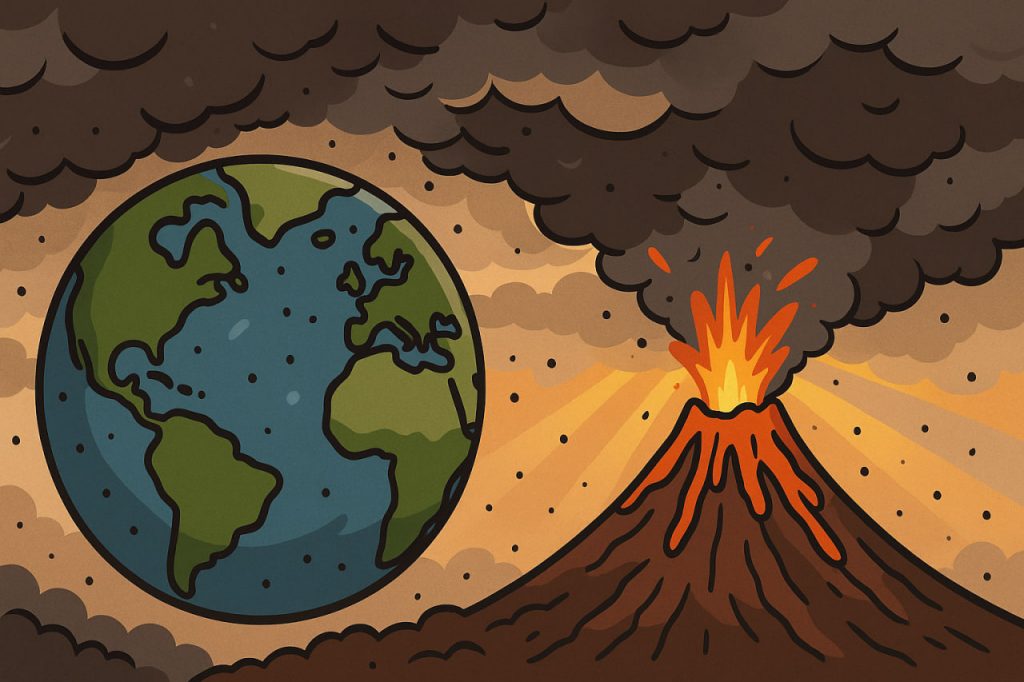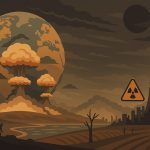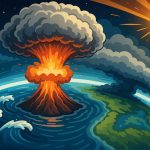Throughout history, volcanic eruptions have dramatically shaped the Earth’s climate. Among the most powerful natural events, a massive eruption can release enough ash and gas to block sunlight and cool the entire planet for years. This phenomenon, known as a volcanic winter, transforms fiery destruction into global cold, disrupting weather patterns, agriculture, and civilizations.
What Is a Volcanic Winter?
A volcanic winter occurs when large quantities of ash, sulfur dioxide (SO₂), and aerosols are ejected into the stratosphere — the upper layer of Earth’s atmosphere. These particles reflect and absorb sunlight, reducing the amount of solar energy that reaches the surface. The result is a measurable drop in global temperature, lasting months or even years.
While the surface cools, the stratosphere warms, altering jet streams and precipitation patterns. This imbalance can cause crop failures, famine, and even mass migrations — as history has shown multiple times.
The Mechanism Behind the Cooling
When a volcano erupts violently, gases like sulfur dioxide mix with water vapor to form sulfate aerosols — tiny reflective particles that scatter sunlight back into space.
Unlike volcanic ash, which settles within days or weeks, these aerosols can linger in the atmosphere for years. The larger and higher the eruption, the greater its climate impact.
For example, eruptions reaching the stratosphere (over 10–15 km high) can influence the global climate, whereas smaller ones only affect local weather.
Historical Examples of Volcanic Winters
Mount Tambora, 1815 – “The Year Without a Summer”
The eruption of Mount Tambora in Indonesia was one of the largest in recorded history. It released around 150 cubic kilometers of material into the air. The following year, 1816, became known as the “Year Without a Summer” — snow fell in June in Europe and North America, crops failed, and famine spread worldwide. Global temperatures dropped by up to 3°C.
Krakatoa, 1883
Another Indonesian eruption, Krakatoa’s explosion was heard thousands of kilometers away. It ejected so much dust that sunsets turned bright red and orange for months. Global temperatures fell by about 1.2°C, and the cooling persisted for several years.
Mount Pinatubo, 1991
The eruption of Pinatubo in the Philippines was the second-largest of the 20th century. It emitted about 17 million tons of SO₂, lowering global temperatures by 0.5°C for nearly two years. NASA satellites recorded significant reductions in solar radiation.
Ecological and Social Consequences
Volcanic winters cause far-reaching effects on ecosystems and societies:
- Agricultural collapse — reduced sunlight and shorter growing seasons destroy crops.
- Food shortages — widespread famine can follow, especially in pre-industrial societies.
- Ocean cooling — decreased sunlight alters marine productivity.
- Migration and societal change — historical records link eruptions to the fall of empires and shifts in population centers.
For example, the Minoan civilization may have declined partly due to the eruption of Thera (Santorini) around 1600 BCE, while the Roman Empire experienced agricultural crises following major eruptions in late antiquity.
Could a Volcanic Winter Happen Again?
Yes. Modern science suggests that a supervolcanic eruption, such as those at Yellowstone or Toba, could once again trigger global cooling. Even smaller eruptions could have serious short-term effects on agriculture, especially in our interconnected world.
While technology today can help predict eruptions and monitor atmospheric changes, no system could completely prevent the climatic consequences of a massive volcanic event.
Volcanic Winter and Modern Climate
Interestingly, studying volcanic winters helps scientists understand climate change. The cooling effect of volcanic aerosols provides insights into how atmospheric particles influence temperature.
Some geoengineering proposals even suggest mimicking this natural process — injecting aerosols into the stratosphere to counteract global warming. However, such methods carry unpredictable risks.
Interesting Facts
- The 1815 Tambora eruption released more energy than 1.5 million Hiroshima bombs.
- Volcanic aerosols can remain in the stratosphere for 2–3 years.
- “The Year Without a Summer” inspired Mary Shelley to write Frankenstein due to dark, stormy weather.
- NASA data from Pinatubo confirmed a measurable decrease in sunlight across the globe.
- Large eruptions occur roughly once every 1,000 years on average.
Glossary
- Volcanic winter — global cooling caused by volcanic gases and aerosols blocking sunlight.
- Stratosphere — the atmospheric layer above the troposphere where aerosols can remain for years.
- Sulfate aerosols — tiny reflective particles formed from volcanic sulfur gases.
- Supervolcano — a volcano capable of ejecting over 1,000 cubic kilometers of material in one eruption.
- Geoengineering — deliberate modification of Earth’s climate systems to counteract warming.


